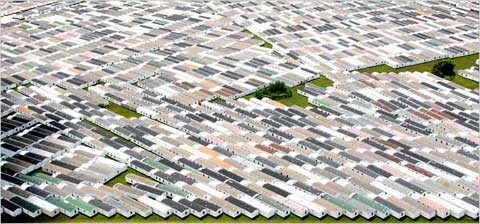News & Notes Archive - July 2006
All those post-Katrina FEMA units —what will become of them? A note of caution
The Katrina post-mortem continues, and, oh, what a mess and a boondoggle it is. The Inspector General of the Dept. of Homeland Security has been outspoken in his criticism of FEMA for incredible incompetence and waste, especially its emergency shelter purchases after last year’s hurricanes. According to his report, FEMA bought a whopping 24,967 manufactured homes after Hurricane Katrina at a cost of $862.7 million dollars of taxpayers’ money. Of that total, more than two thirds, or more than 17,000 remain in storage in several staging areas, in particular Hope, Arkansas, where 10,167 FEMA units were packed together in a huge open field.

More than $300 million worth of cheap-o single-wide manufactured homes are stored here in Hope, Arkansas. These are very low-end bare bones 14’x60’ singlewides for emergency shelter only. God help consumers if any of these find their way onto the retail market.
These single-wides were specially constructed as emergency shelter, for temporary use only, and should never be allowed to enter the retail marketplace. But that didn’t stop some fast-buck operators from trying to buy a big chunk of them for pennies on the dollar to do precisely that. Last month one scheduled auction was cancelled at the last minute after MH industry officials protested the sell-off. At this writing no other auctions have been allowed. Keep your fingers crossed.
Just one indication of how screwed up FEMA’s posts-Katrina response was, the Inspector General’s investigators were unable to even identify the FEMA official(s) who authorized the purchase of manufactured homes in the first place! That would be comical were it not that it was our tax dollars that were squandered. As it stands now, the governments will be paying $47 million just to maintain the stored homes during 2006.
At this writing, FEMA intends to deploy many of the homes to locations around the country where they will serve as emergency shelter for future disasters, or “donated” to other federal agencies that may have a need. But with pressure on to recapture lost taxpayer dollars, you can anticipate that many of these homes will be sold eventually. So, be cautious if you’re looking for a low end single wide on the repo market, because that’s most likely where these cut-rate single-wides will likely show up in the retail marketplace.
Many builders of HUD-code homes also offer the same or similar models built to the modular code–an option worth considering
As you visit retail sales centers to look at models of manufactured homes, you’ll likely find some retailers also feature a few models built to the modular code. In contrast to manufactured homes (i.e., those built to the HUD-code), homes built to modular codes (and there are several) are not built on a steel frame chassis with wheels and towed to a home site. Rather, they are built as sections and transported on a flat-bed tractor-trailer and usually craned into position on a permanent foundation.
In general, even modest modular homes have higher construction quality than manufactured homes, they’re more complex, and there is more on-site construction that must occur to complete and trim out the home—up to 25% of the final construction occurs on site (as opposed to 5% for manufactured homes).
Modulars can also be very high end. In recent years there has been a strong trend of building luxury homes costing millions using modular building systems, principally because they can save time and money over conventional site-building.
Yes, modular homes cost more than manufactured homes but they have two advantages: lenders generally regard them like site-built homes when qualifying them for conventional home mortgages, which means greater ease of obtaining a loan, and generally at lower rates. And the homes themselves don’t have the social stigma of being “a mobile home.” Most look indistinguishable from site-built.
Drawbacks you may encounter: delivery times can be longer, sometimes months longer, if the home you order is anything more complicated than a “two-“ or a “three-box” model; and successful placement and final construction finish out requires a well-qualified general contractor very familiar with assembling modular components.
Note: You may come across a hybrid home model: a modular home built on a HUD-code chassis. These so-called “Hudular homes” are odd-ball exceptions developed to qualify for conventional financing, but the ploy doesn’t always work. Bank appraisers take one look at the steel frame chassis under the sections and, “sorry, it’s a mobile home.” Avoid these types of homes. For starters, they represent a mish-mash of construction features that can seriously erode the home’s resale value